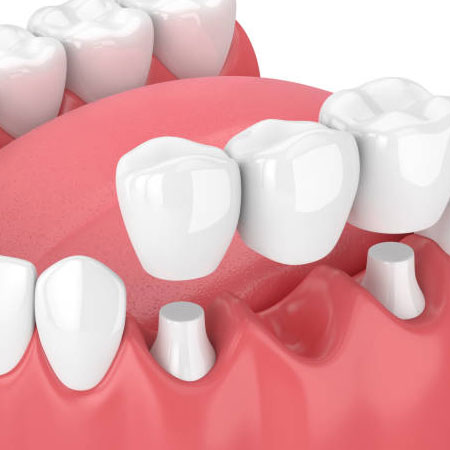In the realm of dentistry, dental crowns and bridges play pivotal roles in restoring the functionality and aesthetics of teeth. Whether due to decay, damage, or missing teeth, these prosthetic devices offer effective solutions, enabling individuals to regain confidence in their smiles and oral health. This comprehensive guide aims to shed light on what dental crowns and bridges are, how they work, their various types, the procedure involved, benefits, potential risks, and aftercare tips.
What are Dental Crowns?
Dental crowns, also known as caps, are custom-made covers that encase damaged, decayed, or weakened teeth, restoring their strength, shape, size, and appearance. Crafted from various materials such as porcelain, metal, or a combination of both, dental crowns mimic the natural color and texture of teeth, ensuring a seamless blend with the rest of the dental arch. Crowns are meticulously designed to provide durability and functionality while enhancing the overall aesthetics of the smile.

Types of Dental Crowns
Porcelain Crowns
Porcelain crowns offer exceptional aesthetics, closely resembling the natural color and translucency of teeth. They are an ideal choice for front teeth restoration due to their lifelike appearance.
Metal Crowns
Metal crowns, typically made of gold or silver alloy, provide unparalleled strength and durability. Although they are less aesthetically pleasing, they are often recommended for molars or teeth subjected to heavy biting forces.
Porcelain-Fused-to-Metal (PFM) Crowns
PFM crowns combine the strength of metal with the natural appearance of porcelain. They offer a balance between aesthetics and durability, making them suitable for both front and back teeth restoration.
All-Ceramic Crowns
All-ceramic crowns are crafted from high-strength ceramic materials, providing excellent aesthetics and biocompatibility. They are an ideal choice for individuals with metal allergies or those seeking a metal-free restoration option.
What are Dental Bridges?
Dental bridges are prosthetic devices used to replace one or more missing teeth by bridging the gap between adjacent teeth. Comprising artificial teeth called pontics, dental bridges are anchored in place using dental crowns or implants, restoring both the function and appearance of the smile. Bridges come in various types, each catering to different patient needs and preferences.
Types of Dental Bridges
Traditional Dental Bridges
Traditional bridges consist of pontics held in place by dental crowns, which are cemented onto the adjacent natural teeth or implants. They are a popular choice for replacing one or more consecutive missing teeth.
Cantilever Bridges
Cantilever bridges are similar to traditional bridges but are anchored on only one side, making them suitable for areas with only one adjacent tooth.
Maryland Bridges
Maryland bridges, also known as resin-bonded bridges, feature pontics supported by metal or porcelain framework bonded to the backs of adjacent teeth. They offer a conservative option for replacing missing front teeth.
Implant-Supported Bridges
Implant-supported bridges utilize dental implants as anchor points instead of natural teeth. They provide superior stability and prevent bone loss while eliminating the need to involve adjacent healthy teeth.
Procedure for Dental Crown and Bridge Placement
The process of getting dental crowns or bridges typically involves multiple steps
Initial Consultation
The dentist assesses the patient's oral health, discusses treatment options, and develops a personalized treatment plan.
Tooth Preparation
For crown placement, the affected tooth is prepared by removing decay and reshaping it to accommodate the crown. Impressions of the prepared tooth are then taken for crown fabrication.
In bridge placement, the adjacent teeth are prepared similarly to receive the crowns that will support the pontic(s).
Temporary Restoration
A temporary crown or bridge may be placed to protect the prepared tooth or teeth while the permanent restoration is being fabricated.
Fabrication
Dental crowns and bridges are custom-made in a dental laboratory based on the impressions taken. The choice of material is determined by factors such as aesthetics, durability, and patient preference.
Final Placement
Once the permanent restoration is ready, the temporary crown or bridge is removed, and the final restoration is cemented or bonded in place.
Follow-up:
Patients are advised on proper oral hygiene practices and may be scheduled for follow-up appointments to ensure the longevity and functionality of the crown or bridge.
Benefits of Dental Crowns and Bridges
- Restored Functionality: Crowns and bridges enable individuals to chew, bite, and speak with ease, restoring normal oral function.
- Improved Aesthetics: These prosthetic devices enhance the appearance of the smile by concealing imperfections and filling in gaps left by missing teeth.
- Preservation of Oral Health: By protecting and strengthening damaged or weakened teeth, crowns help prevent further decay or fracture, thereby preserving oral health.
- Longevity: With proper care and maintenance, dental crowns and bridges can last for many years, providing lasting solutions for tooth restoration.
Aftercare Tips
To ensure the longevity and functionality of dental crowns and bridges, patients should adhere to the following aftercare tips
Maintain Excellent Oral Hygiene
Brush teeth twice daily, floss regularly, and use antimicrobial mouthwash to prevent plaque buildup and maintain gum health.
Avoid Hard Foods
Refrain from biting on hard objects or consuming excessively sticky or hard foods that may damage the crowns or bridges.
Attend Regular Dental Check-ups
Schedule routine dental visits for professional cleanings and examinations to detect any issues early and ensure the longevity of the restorations.
Address Concerns Promptly
If any discomfort, sensitivity, or issues with the crown or bridge arise, promptly contact your dentist for evaluation and necessary adjustments.
Dental crowns and bridges are indispensable tools in modern dentistry, offering effective solutions for restoring damaged, decayed, or missing teeth. Whether it's enhancing aesthetics, improving functionality, or preserving oral health, these prosthetic devices play a crucial role in helping individuals regain confidence in their smiles and overall well-being. By understanding the different types, procedure involved, benefits, risks, and aftercare tips associated with dental crowns and bridges, patients can make informed decisions and embark on their journey towards a healthier, more radiant smile.
